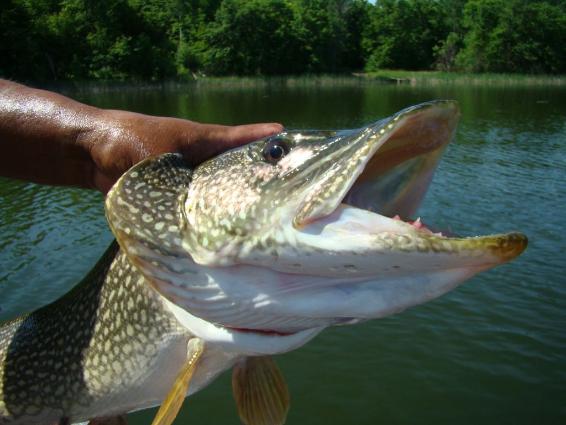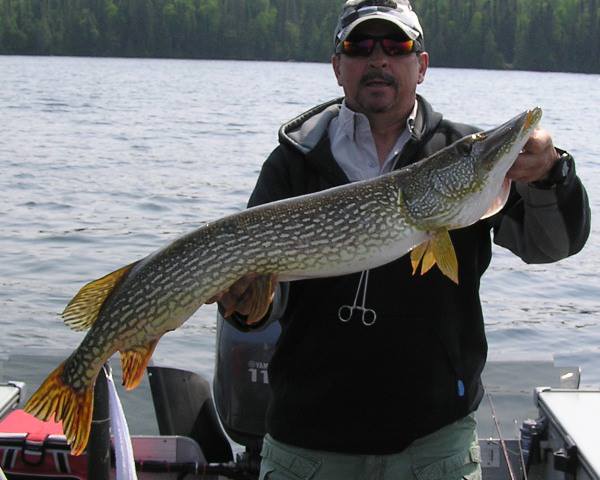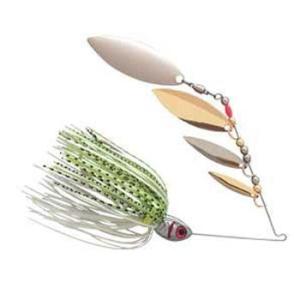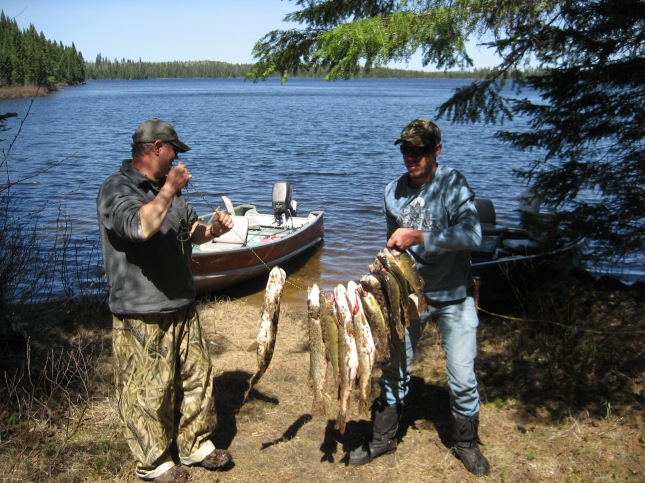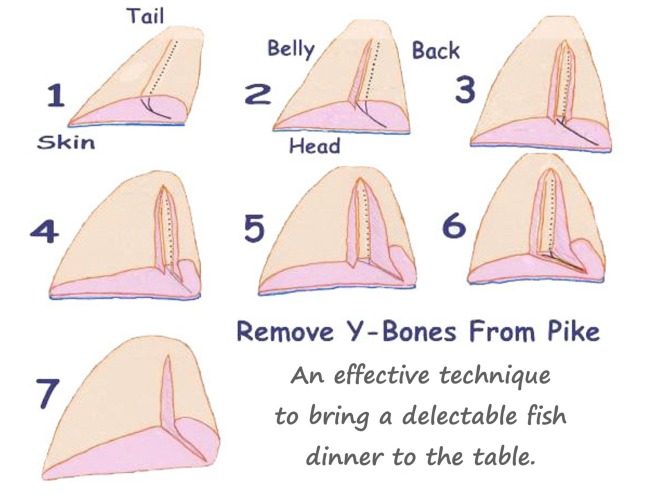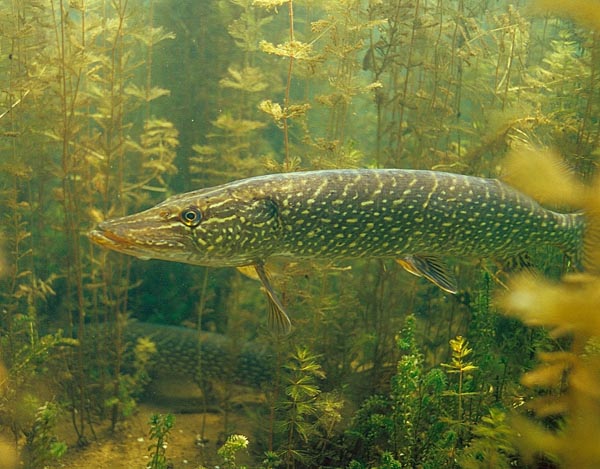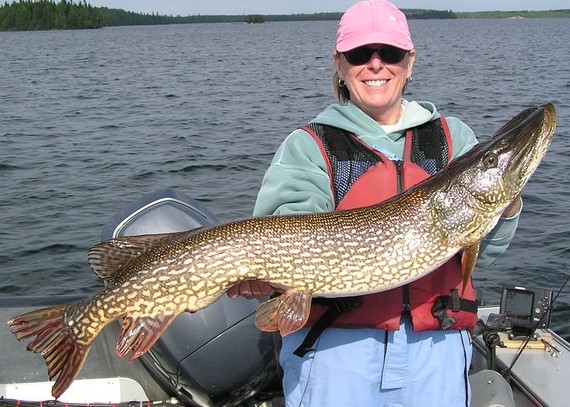 The #5 Mepps’ steady throb pulsed through the 30-pound Spiderwire, down the length of the medium/heavy-action graphite rod and directly into his hand. Just as the lure reached the edge of the cabbage weeds, the blade’s thrum came to an abrupt halt. He set the hook hard into what felt like a concrete wall! But then the wall began to move, and he knew he was into a trophy. Five minutes later and four desperate boatside runs, he lands the 20-pound northern pike.
The #5 Mepps’ steady throb pulsed through the 30-pound Spiderwire, down the length of the medium/heavy-action graphite rod and directly into his hand. Just as the lure reached the edge of the cabbage weeds, the blade’s thrum came to an abrupt halt. He set the hook hard into what felt like a concrete wall! But then the wall began to move, and he knew he was into a trophy. Five minutes later and four desperate boatside runs, he lands the 20-pound northern pike.
IT’S SIMPLE: Big pike LOVE spinners!
Weeds are the keys to spinning big pike crazy as these predators use vegetation to ambush any aquatic creature smaller than themselves.
The Baits
Spinner choices abound, but not all are created equal when it comes to enticing jumbo “scissorbills.” The angler should select certain sizes, shapes, and colors, over others.
 Lesson No. 1 in choosing spinners for Esox lucius: bigger always is better. Pick magnum-sized offerings as even hammer-handles attack huge lures with abandon, and to catch true monsters, you MUST have that big profile.
Lesson No. 1 in choosing spinners for Esox lucius: bigger always is better. Pick magnum-sized offerings as even hammer-handles attack huge lures with abandon, and to catch true monsters, you MUST have that big profile.
Fat, deeply cupped blades throw out big vibrations that ring the dinner bell for monster pike. While sometimes thinner shaped blades (such as willow-leafs) that spin faster turn the trick; usually the slower-turning Colorado-type blades prove to be the ticket to a pike bonanza.
Because big flash stimulates lunkers, polished silver and gold blades work great. Another killer color combo, especially for use in darker, stained water, is orange blades with a black trailer.
In-Line vs. Offset Spinners
Spinners for northerns come in two basic designs, and both work effectively, but each has its strengths and weaknesses.
This slideshow requires JavaScript.
In-line spinners (such as Mepps, Worden’s Lures Rooster Tails, Panther Martin, and Blue Fox’s Vibrax), with their terminal trebles, have higher hook-up and catch rates than their safety-pin brethren, but they also hook vegetation and other underwater structure, too.
But lures such as Terminators and Stanley Jigs’ Rick Clunn 4-Blade Willow Spinnerbaits, with their single, upturned hooks surrounded by manmade skirts, slither through the weeds, logs and stumps. In-lines also cast like bullets, while offsets can catch the wind and lose momentum.
Line, Leaders
Any of the new “super-lines” such as like Berkley FireLine, Spiderwire Fusion, or Remington’s Power-Lokt, are superior to monofilament for spinning pike angling. Their low stretch and high-abrasion resistance benefit pike anglers.
Flout the convention and tie on a snap/swivel instead of a leader. Leaders inhibit action and deter wary trophies, while the snap swivels provide two major benefits: quick lure changes and eliminating/reducing line twist. True, you’ll lose lures to the razor-sharp choppers of aggressive mounters, but you’ll get lots more bites without leaders!
Speed & Delivery
Often northerns will attack even jet-powered offerings, but slowing down, pausing, or herky-jerkying that spinner, especially when it reaches the “Pike Zone,” reaps big rewards. Even lazy fish will smash a spinnerbait dangled in front on their out-sized mouth.
Always cast beyond where you think the pike lurk, because while “scissorbills” are legendary for their aggressiveness, they don’t like being bombed. Landing a bait on top of one’s head will likely result in spooking it.
Spin-Crazy Times & Spots
Primetime for driving pike spin crazy depends upon the season, time of day, and prevailing weather conditions. Early spring, right after ice out, brings spawned out northern pike shoreward (where they’re most vulnerable). Spinner rigs elicit savage strikes from hungry pike during spring.
Because northerns sight-feed, mid-day piking makes sense. Following that logic, clear, blue-sky days with lots of sun create perfect pike angling weather.
 The spinner’s flash and large profile, easily visible to cruising whoppers, prove irresistible.
The spinner’s flash and large profile, easily visible to cruising whoppers, prove irresistible.
Look for incoming streams or rivers, and concentrate your efforts just off the edges of weedy drop-offs. Weeds are the keys to spinning big pike crazy, as these predators use vegetation to ambush any aquatic creature smaller than themselves. Position the boat on the deep side of the drop-off, and cast the spinner up onto the flat itself, cranking just fast enough to keep the lure above the weeds, and pause when you get to the weed edge. Allow the bait to drift down and find the waiting lunkers, and hang on!
Using spinners to drive northern pike stir crazy is fun, easy, and productive.
Contact us for your next MONSTER PIKE Fishing Trip!
Follow our HUNTING BLOG
WEB RATES FISH HUNT CABINS PHOTOS







